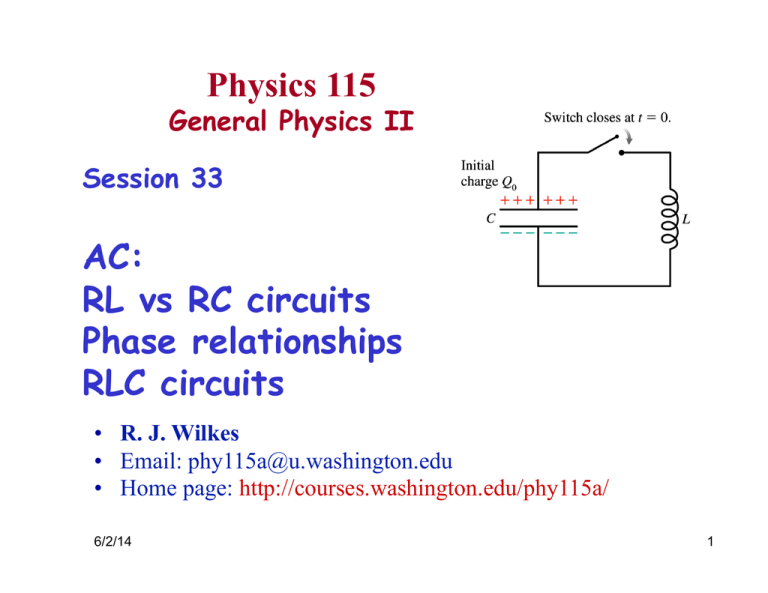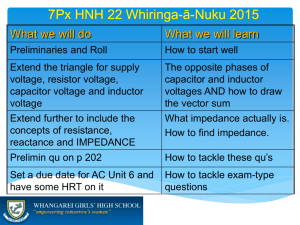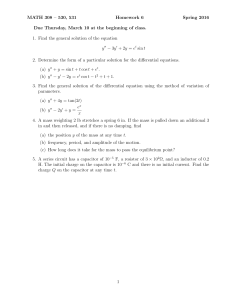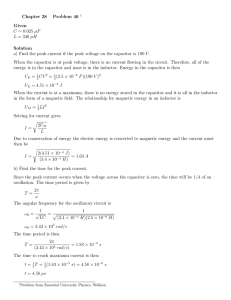Physics 115 AC: RL vs RC circuits Phase relationships RLC circuits
advertisement

Physics 115 General Physics II Session 33 AC: RL vs RC circuits Phase relationships RLC circuits • R. J. Wilkes • Email: phy115a@u.washington.edu • Home page: http://courses.washington.edu/phy115a/ 6/2/14 1 Lecture Schedule Today 6/2/14 Physics 115 2 Announcements • Final exam is one week from today! 2:30 pm, Monday 6/9, here • 2 hrs allowed, will probably take you about 1 hr • Comprehensive, but with extra items on material covered after exam 3 • Final exam will contain ONLY Ch. 24 topics covered in class • Usual arrangements, procedures • Homework set 9 is NOT due Weds night, but Friday 6/6, 11:59pm 6/2/14 3 EXAM 3: Scores back from scan shop, should be posted soon AVG: 66 STD. DEV: 17 6/2/14 4 6/2/14 5 6/2/14 6 5) 6/2/14 7 6/2/14 8 6/2/14 9 9) 6/2/14 10 6/2/14 11 6/2/14 12 6/2/14 13 6/2/14 14 Root-Mean-Square V and I “RMS” stands for “root-mean-square” 1. square the quantity (gets rid of polarity) 2. average the squared values over time, 3. take the square root of the result. P is proportional to I2 , so RMS gives us the equivalent DC voltage in terms of power: DC voltage that would dissipate the same power in the resistor (same joules/sec heating effect) 2 ⎛ I ⎞ P = 12 I R2 R = ⎜ R ⎟ R = ( I RMS )2 R ⎝ 2 ⎠ I and V I RMS IR ≡ 2 R VRMS ≡ VR 2 R = peak values ERMS ≡ 2 ( V ) PR = ( I RMS )2 R = RMS = I RMSVRMS R Psource = I RMSERMS 6/2/14 Physics 115 ER 2 15 Inductors in AC Circuits For AC current iR through an inductor: The changing current produces an induced EMF = voltage vL. Δi vL = L L Δt For the AC circuit as shown, Kirchhoff’s loop law tells us: ΔV + ΔV = E − v = 0 source L L E (t) = E cos ω t = v 0 L “It can be shown” (calculus) that: "1% " " V V π% π% ΔiL = $ ' v L Δt → iL = L sin ω t = L cos $ω t − ' = I L cos $ω t − ' ωL ωL 2& 2& # L& # # Notice: the inductor current iL lags the voltage vL by π/2 radians =900, so that iL peaks T/4 later than vL. 6/2/14 Physics 115 For inductors, ωL acts like R in Ohm’s Law: I = V/ R à IL=V/(ωL) 16 Inductive Reactance For AC circuits we define a resistance-like quantity, measured in ohms, for inductance. It is called the inductive reactance XL: X L ≡ ω L = 2π f L We can then use a form of Ohm’s Law to relate the peak voltage VL, the peak current IL, and the inductive reactance XL in an AC circuit: IL = 6/2/14 VL XL and VL = I L X L Reactance is not the same as resistance: it depends on f (time variation), and current is not in phase with voltage! Physics 115 17 Capacitors in AC Circuits For AC current iC through a capacitor as shown, the capacitor voltage vC = E = E0 cos ωt = VC cos ωt. The charge on the capacitor will be q = C vC = C VC cos ωt. iC = dq d = ( CVC cos ωt ) = −ωCVC sin ωt dt dt iC = ωCVC cos(ωt + π / 2) So: AC current through a capacitor leads the capacitor voltage by π/2 rad or 900. 6/2/14 Physics 115 18 Capacitive Reactance For AC circuits we also define a resistance-like quantity, measured in ohms, for capacitance. It is called the capacitive reactance XC : XC ≡ 1 1 = ωC 2π f C Again, we use a form of Ohm’s Law to relate the peak voltage VC, the peak current IC, and the capacitive reactance XC in an AC circuit: Capacitive vs inductive reactance: XL is proportional to f and L VC IC = and VC = I C X C XC is proportional to 1/f and 1/C XC Current leads in capacitors, lags in inductors 6/2/14 Physics 115 19 Example: Capacitive Current A 10 µF capacitor is connected to a 1000 Hz oscillator with a peak emf of 5.0 V. What is the peak current in the capacitor? X C (1000 Hz) = 1 = 15.9 Ω -1 -5 2π (1000 s )(1.0 ×10 F) VC (5.0 V) IC = = = 0.314 A X C (15.9 Ω) 6/2/14 Physics 115 20 Capacitors and springs This is analogous to the behavior of the position and velocity of a mass-andspring harmonic oscillator. AC current through a capacitor leads the capacitor voltage by π/ 2 rad or 900. 6/2/14 Physics 115 21 LC Circuits A charged capacitor is analogous to a stretched spring : stores energy even when the charge is not moving. An inductor resembles a moving mass (remember the flywheel), stores energy only when charge is in motion. Mass + spring = an oscillator. What about a capacitor + inductor? When the switch is closed in the circuit shown in the diagram: 1. The capacitor discharges, creating a current in the inductor. 2. There is no dissipative element (resistor = friction) in this system, so its energy is conserved. 3. So, when the capacitor charge reaches 0, all of its stored (E field) energy must now be stored in the inductor’s B field. 4. Then the current in the inductor falls as it charges the capacitor in the opposite direction. And so on … 6/2/14 Physics 115 22 The Oscillation Cycle 6/2/14 Physics 115 23 Clicker Question In the circuit above, the frequency is initially f Hz If the generator’s frequency is doubled, to 2f, what happens to the inductor’s reactance XL ? A. B. C. D. E. It doubles XL is proportional to f It quadruples It is unchanged It is 50% smaller It is ¼ the original value 24


